The Japanese woman or Japanese diet was developed by nutritionists at the YaELO Clinic (Yaeks). The principle of the technique is based on the consumption of low-calorie foods for 7-14 days. Before starting a strict diet, experts recommend mental training - the weight loss system requires strict adherence to all the rules of the method. This system of weight loss is characterized by prolonged exit: lasts 4 weeks. Despite its high effectiveness, the diet can be harmful to the body, especially if there are contraindications.

The principle of weight loss
The Japanese diet is designed for 7, 14 or 13 days. Proper weight loss is achieved through the use of foods high in protein. Fatty and carbohydrate foods are eliminated from the diet. The technique is considered "salt-free". The initial stage of weight loss is accompanied by the normalization of metabolic processes in the body, the elimination of toxins. The process of burning fat begins in 2-3 days.
It is impossible to deviate from the regime - the diet is strictly prescribed. Due to the lack of carbohydrates in the dishes, the duration of the diet should not exceed 14 days. Adverse reactions require immediate discontinuation of diet therapy and are a reason to seek medical attention. The use of vitamins and minerals during weight loss is stimulated, the complex is selected individually. Withdrawal from the diet can take up to a month.
Dietary rules

Containers made from approved products can fill you up quickly. This is due to the fact that they contain the main "building" component - protein. Carbohydrates and fats enter the body in small amounts. Fiber is found in fresh fruits and vegetables, and their use is not limited. Soluble dietary fiber promotes the normal functioning of the digestive system. The antioxidants involved in metabolism are found in green tea and natural coffee.
A specially selected menu for each day provides the body with the necessary nutrients.
Drinking regimen should be carefully followed: drink at least 1. 5 liters of fluid per day. Salt, sugar and hot spices are not allowed on the plates. The number of meals is limited: no more than 3 times a day. You can't eat snacks.
Experts recommend avoiding sweets and junk food in advance - this will help prevent spoilage. It is recommended to reduce portions.
Permitted and prohibited products
The list of products allowed for consumption is very limited. For 14 days, the daily menu may include:
- meat and poultry products;
- a fish;
- bread;
- vegetables;
- fruits;
- natural freshly squeezed juices;
- Dairy foods;
- tea and non-carbonated mineral water.
Vegetables, fruits and vegetables you can eat:
- zucchini;
- carrots;
- eggplant;
- cabbage;
- an Apple;
- pineapple;
- pear;
- kiwi;
- pomelo;
- citrus fruits (lemon, orange).
Bread and rye should be rye. Lean meat (lean beef, chicken, turkey) and fish (hake, cyan, cod) are heat treated. Eggs are allowed, but in small quantities. Drinks (green tea, natural weak coffee, boiled water) should not contain sweets. You can drink tomato juice and low-fat (1%) kefir. Olive oil is included in the diet.
Prohibited foods should be completely removed from the menu. These include:
- fatty meat and fish;
- vegetable oils;
- salt and sugar;
- fast food;
- flour products;
- smoked and boiled sausages;
- semi-finished products and canned food;
- sweets and confectionery;
- starchy foods (vegetables, cereals);
- alcohol and tobacco products;
- sauces, marinades.
Fruits and vegetables:
- Cherry;
- cherry;
- Pomegranate;
- date;
- mandarin;
- mango;
- figs;
- the fruit of passion;
- grapes
Dried fruits:
- plums;
- raisins;
- dried apricots;
- dates.
The Japanese rarely eat dairy products because they are often lactose intolerant and therefore not included in the diet.
Potato chips, sweet and salty popcorn should be excluded from the diet. Cereals, barley and millet are not used for cooking foods that burn fat.
Prohibited flour products:
- pancakes;
- mantis;
- vareniki;
- spaghetti (noodles);
- pancakes;
- pasta;
- wheat bread;
- cookies.

Confectionery (sweets, cookies, confectionery, buns, cakes, marshmallows, halva, canned food, jam) is strictly prohibited. Spices (spices, mayonnaise, ketchup) are not added to dishes. All dairy products (sour cream, cottage cheese, fermented milk, skim milk, sour cream) are prohibited.
Meat and sausages:
- pork;
- mutton;
- ham;
- boiled pork;
- Salo;
- smoked sausage;
- uncooked smoked, boiled, dried sausage.
Dried, smoked and dehydrated fish should be removed from the diet immediately. Poultry meat is consumed only in boiled form. Do not use chocolate, butter or butter. Alcohol and tobacco products are removed 2-3 weeks before weight loss. Highly carbonated sweet drinks (lemonade, kvass) are replaced by non-carbonated mineral water.
Dried fruit compotes are not included in the diet of jelly drinkers. You should also avoid cherry, apple, pomegranate, grape and orange juices. Nectar is made from pineapple and tomatoes, which they drink in small amounts.
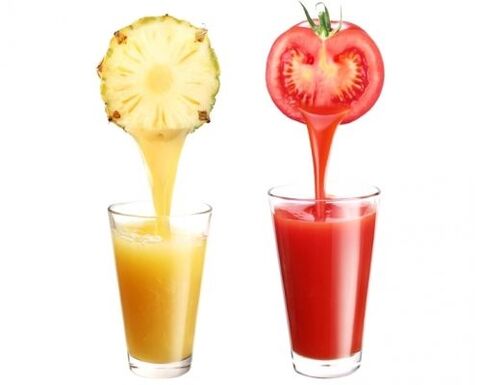
Types of Japanese diet
There are 3 types of Japanese diet. They differ in the number of days:
- 7 days;
- 13 days;
- 14 days.
Regardless of the type of equipment, it is necessary to follow a diet.
The diet is 14 days
The salt-free weight loss system is designed for 2 weeks. During this period, fat cells gradually divide and burn. During the first 3 days, the body is cleansed. During this period, experts recommend drinking plenty of fluids: boiled water and green tea accelerate the release of residual toxins. Conditionally, the diet can be divided into 2 stages, each of which lasts for 7 days. In the first stage, kefir is added to the menu. The dishes are steamed, frying and roasting are not taken into account.
7 days diet
The softest technique is designed for a week. During this period you can lose no more than 3-4 kilograms. The menu is strict, the products are limited and cannot be replaced. During weight loss, restructuring occurs, during which the body adapts to a new diet, so experts believe that this system is the least effective. The menu may include traditional Japanese cuisine prepared with permitted ingredients. They cannot be replenished. For people who are planning to lose weight according to Japanese women, nutritionists recommend choosing the "easy" option.
13 days diet
The principle of operation of this type does not differ from the previous two. The weight of the service does not exceed 200 g, liquid is consumed when thirsty. Receipt of food - 13 days at the same time. It is mandatory to follow all the rules of detox diet. In less than 2 weeks, the bowel is completely cleansed, the process of burning fat is gradual, so the skin in problem areas retains its elasticity. The energy source consumed is replenished with protein products.
Daily diet scheme
Slimming dishes are completely adapted to European cuisine and do not contain exotic ingredients. The approximate menu is calculated for 7 days and is repeated on the 8th day. Substitutes are allowed: replace coffee with green tea, kefir - with tomato juice. The daily rate of production, if necessary, is divided into 2 parts depending on the number of days (weekly weight loss).
Diet scheme (for 14 days):
- chicken meat - 1 kg;
- fish fillet - 2 kg;
- lean beef - 1 kg;
- crackers or rye bread - 0, 5 kg;
- chicken eggs - 20 pieces;
- white cabbage - 2 pieces; .
- zucchini and / or eggplant - 1 kg;
- carrots - 2, 5-3 kg;
- fruits (not sweet) - 1 kg;
- lemon (large) - 2 pieces;
- kefir (low fat) - 1 liter;
- olive oil - (cold press) - 0, 5 liters;
- tomato juice (at home) - 1 liter;
- natural coffee (grain or powder) - 1 pack;
- green (large leaf) tea - 1 pack.
Water consumption depends on a person's age and weight.
The food complex is enough to eat three times a day. Non-carbonated mineral water can be replaced with boiled water. The minimum amount of fluid per day is 1. 5 liters.
Detailed plan of the daily menu (by day):
- For breakfast (8. 00) - a cup of weak natural coffee. Do not add sour cream, sugar or condensed milk. Lunch (13. 00) - finely chopped cabbage boiled in its own juice with a little olive oil, 2 registered boiled eggs and 250 ml of tomato juice. For dinner (18. 00) - fish (200 g boneless fillet), steamed or boiled.
- Breakfast - coffee without milk and sugar, rye bread. Lunch - cabbage cooked in olive oil and steamed (boiled) fish fillets (100 g). Dinner - boiled beef (100 g) and 250 ml of low-fat kefir.
- Breakfast is a cup of weak natural coffee and a cup of rye. For lunch - vegetable soup with eggplant or zucchini. Dinner - salad of fresh white cabbage with oil. You can eat 2 eggs and 200 g of boiled lean beef (pulp).
- Breakfast - raw carrot puree, lemon juice. Lunch - boiled boneless fish fillet (200 g), 250 ml of tomato juice. Dinner is an infinite amount of fruit.
- For breakfast - raw carrot puree, lemon juice. For lunch - boneless fish fillets (200 g), a glass of tomato juice. For dinner - any amount of fruit.
- Breakfast - coffee without sugar or green tea. Lunch - 0, 50 boiled chicken (skinless breast or thigh), fresh vegetable salad with a little fat (carrots and cabbage). Dinner - boiled chicken eggs (2 pcs. ), Salad of freshly chopped carrots with butter.
- Breakfast - green tea without sugar. For lunch - boiled or boiled beef. For dinner - any meal (except for 3 nights dinner).
The menu can be displayed schematically. Experts recommend placing the drawing page in a prominent place.
The right way to get out of the diet
One type of diet should be followed 2-4 weeks after the diet. During weight loss, the body adapts to small portions and low-calorie foods. Abstinence from diet is necessary for maintaining a normal weight and optimal functioning of the digestive system. It is recommended to gradually return to a normal diet: carbohydrate-rich foods are added a little every day. The duration of the release is at least 14 days.
Food should be in portions and portion weight should not be increased. Diet should be dominated by foods that contain small amounts of calories and replenish energy in the process of losing weight. Reduction of protein products (chicken eggs, poultry and fish) is not recommended. Fats and carbohydrates are gradually added to the menu. Salt and sugar can be added in micro doses. Drinks should be plentiful, not to exceed 2 liters per day.
Breakfast cereals are allowed during the fasting period. Oats, buckwheat and rice are boiled in water. Eat as many raw fruits and vegetables as you want. It is best to give preference to sweet and sour varieties of apples. Discounts are included between main dishes: a glass of kefir or rice cakes. Rye bread is replaced by whole grain or unleavened bread.
Pasta and confectionery, baked goods and snacks are not included in the diet.
The cost of the diet
Products approved for use in weight loss are in the middle price category.
Advantages and disadvantages
Japanese techniques for weight loss have a number of advantages and disadvantages. Benefits include:
- efficiency;
- accessibility;
- cleansing at the same time as weight loss;
- full menu;
- Three times a day;
- increase muscle tone.
The efficiency depends on the rapid process of fat burning, the result appears after 7 days. The products are available to everyone and can be purchased at any store. There is no need to calculate calories in advance, the menu is clearly written. Meals are taken 3 times a day, the diet is heartfelt, so the feeling of hunger is rare. Cleansing the body helps to normalize metabolic processes. Foods are high in protein, which strengthens muscle structure.
Disadvantages are:
- unbalanced diet;
- deficiency of vitamins and minerals;
- lack of breakfast;
- the need to follow the rules of dieting;
- short-term weight loss;
- Contraindications.
An unbalanced diet and a lack of fats, proteins, and carbohydrates increase the risk of side effects. Decreased natural defenses, deterioration of nails and hair occur against the background of vitamin deficiency in the body. Proper diet prevention can lead to the development of stressful situations and rapid weight loss.
Contraindications and harm

The diet is suitable only for healthy people. Before losing weight, you should undergo an examination and consult a nutritionist. Contraindications include:
- pregnancy at any time;
- breastfeeding;
- ulcers of the stomach and duodenum;
- erosive disorders of the digestive system;
- pathology of the kidneys and liver, including failure;
- anemia;
- gallbladder disease;
- diseases of infectious etiology;
- pathology of the cardiovascular system;
- hypovitaminosis;
- Diabetes mellitus;
- blood pressure rises;
- exacerbation of chronic diseases;
- gout
The diet is not suitable for the elderly and adolescents. Failure to follow the general rules of technology increases the negative effects. In the early days, dizziness and urinary incontinence (constipation or diarrhea) may occur. Digestion is accompanied by excessive flatulence or colic. There is an unpleasant odor, heartburn and belching. Headaches occur against the background of complete rejection of sugar.
Neurosis and sleep disorders also occur for this reason. Lack of fat causes a bitter taste in the mouth. The appearance may worsen: the skin becomes pale and dry. Malnutrition leads to joint disease.
Diet recipes
Dietary foods are added after leaving the menu. You can diversify your diet with salads, first and second courses. Low-sugar home-made desserts improve brain function and can be eaten after 14-15 days.
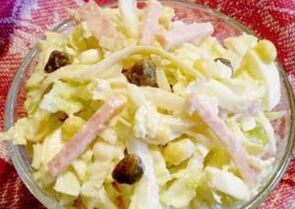
The "Hope" diet salad contains the following ingredients:
- potatoes - (2 pcs. );
- milk sausage - (2 pieces);
- chicken breast - (250 g);
- pickled cucumbers - (1 pc. );
- greens;
- salt;
- olive oil - (1 tbsp).
Diced boiled potatoes, boiled chicken and sausage. Put the mass in a deep bowl and mix with salt. Add sliced cucumber and finely chopped vegetables.
Grease the salad with olive oil (first press).
Cabbage salad:

- Peking cabbage - (250 g);
- fresh cucumbers and tomatoes - (250 g);
- chili pepper - (1 piece);
- hard cheese - (150 g);
- salt;
- olives (1/2 can);
- olive oil.
Cut the Chinese cabbage leaves into small pieces by hand. Cucumbers and tomatoes are cut into large pieces. Grind the chili (half a vegetable) in a blender. Mix all ingredients, salt and oil. Garnish the salad with grated cheese and olives.
First courses are for lunch. Soups are made in the form of puree for easy digestion. Spinach and celery soup:
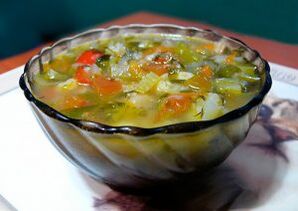
- lemon - (1 piece);
- tomatoes - (2 pcs. );
- spinach - (200 g);
- celery - (stalk, 2 pcs. );
- greens;
- vegetable broth - (1, 5 liters);
- salt;
- olive oil - (1 tbsp. L. ).
Pour the olive oil into a preheated pan. Finely chop the celery stalk and cook in oil. Boil the broth in a separate pot, put sliced spinach in it and cook for 5-7 minutes. Peel a squash, grate it and squeeze the juice. Add the tomato paste to the spinach. Season the soup with salt and fry. Bake for 15–20 minutes. Add a little lemon juice and chopped herbs to the finished soup.
Mushroom Soup Soup:
- champignons - (8 pcs. );
- potatoes - (2 pcs. );
- zucchini - (300 g);
- carrots - (1 piece);
- onion - (1 piece);
- weak meat broth - (1 l);
- flour - (1 tbsp. L. );
- olive oil - (2 tbsp. L. );
- sour cream - (1 tbsp. L. ).
Finely chop the boiled vegetables and blend in a blender. Bring the broth to a boil. Fry the flour until golden brown, add to the soup and add the vegetable puree. Cook the soup over low heat until thickened, then add salt and sour cream and garnish with herbs. The first course is served with rye croutons.
Beef with vegetables:
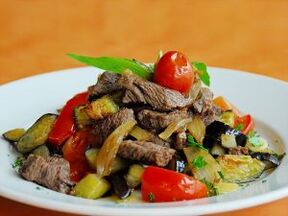
- beef - (500 g);
- olive oil - (3 tbsp. L. );
- potatoes - (200 g);
- carrots - (1 piece);
- Bulgarian pepper - (1 piece);
- onion - (1 pc. ).
Spread onion, bell pepper and chopped carrot in half rings in olive oil. Beef is boiled until half cooked, cooled and cut into small strips. Put the meat on the fried vegetables and salt. Put sliced potatoes on top. Salt again. Pour the meat broth over the vegetables. Bake on low heat for 25-30 minutes.
Indian manti is a dietary food, the preparation of which takes place in 2 stages. Ingredients for the dough:
- flour - (1, 5 cups);
- warm water - (1 glass);
- salt
Dissolve the salt in warm water. Pour flour on the work surface, including depression. Pour salted water over the pieces and slowly knead the elastic dough. Cover it with a towel and leave for 15-20 minutes.
When the dough "sinks", you need to prepare the dressing. Required components:
- champignons - (6-8 pieces);
- carrots - (1 piece);
- green onions - (4-5 feathers);
- zucchini - (400 g);
- olive oil - (2 tbsp. L. );
- tomato paste - (2 tablespoons. l. );
- chicken fillet - (400 g).
Cut mushrooms, zucchini and carrots into small cubes. Boil the chicken and cut into strips. Fry onions in oil and tomato paste, gradually add carrots, zucchini, mushrooms and meat. Pour 150-200 ml of water into the frying pan and bring the vegetables to a boil.
Divide the dough thinly and grease each one. Divide the strips into squares lined up on top of each other (10x10 cm). Bake the dough in the oven or in a slow oven for 15-20 minutes. The "columns" of dough are placed on a plate, topped with vegetable sauce and sprinkled with herbs.
Conclusions and feedback
You can lose 8-9 kg in 2 weeks. Most women and men who lose weight using this technique are positive about it.
First review, female, 36 years old
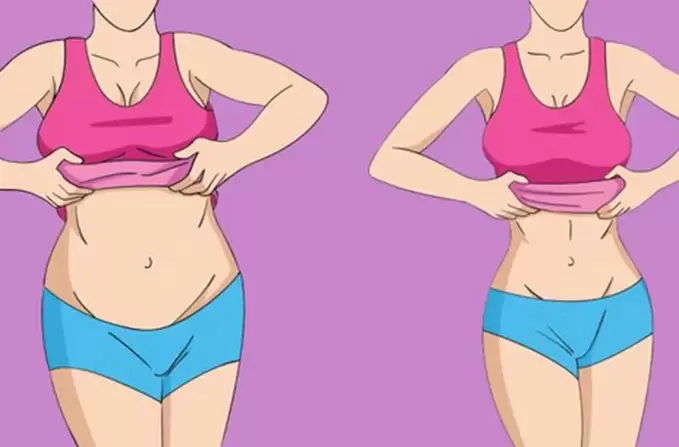
I started recovering as a teenager and tried many diets - they didn’t help. I went to a nutritionist, underwent a medical examination, ate a separate meal, counted calories regularly, organized fasting days, and lost only 2 kilograms in 5 months. A friend advised me of the Japanese fat burning system, and I could not lose 7 kg in 2 weeks. I decided to give it a try.
The medical examination did not show any contraindications. The nutritionist gave detailed recommendations regarding the diet. The system does not require large material investments. At the doctor's suggestion, he painted the menu in detail and attached a sheet to the refrigerator. For the first 3 days I almost fell: the portions looked small, there was always a feeling of hunger. Day 4 was easy, I tried to chew for a long time and drink more fluids.
The second stage of weight loss quickly flew away. I cooked in the machine: I remembered the ingredients and the weight of the dishes. The food began to feel satisfactory, and the hunger was almost gone. On day 3, there were no side effects, except for a short-term headache. The nutritionist explained that this was due to a lack of sugar. I stopped the diet for 20 days. I enjoyed going out, so I avoided sweet, fatty, salty, and smoked foods altogether. I am satisfied with the result: I lost 10, 5 kg in 2 weeks. Six months later, I still use this weight loss system.
Second Review, Woman, 28
I learned about the technique 2 years ago. At that time, his weight was 107 kg, an increase of 164, which is very important. I had health problems, and I was not happy with my appearance. His friends could not advise on an effective diet, so he decided to consult a specialist. The doctor suggested trying to lose weight using the Japanese weight loss system. The long list of foods was scary at first, but the nutritionist explained the diet in detail.
Gained 5 kg in 7 days. The dishes on the menu are heartfelt and I ate a portion. At first, there was a slight dizziness and a slight disturbance of the intestines. The negative effects disappeared by themselves. He ate at the same time. The second stage of weight loss was easy: lightness, appearance and general well-being improved. As a result of my diet, I quit smoking and gave up alcohol altogether. 13 kg went during the release period. For 1, 5 years I have been eating properly, swimming and running, and my weight has not returned.

















































































